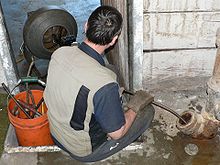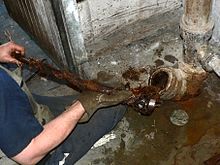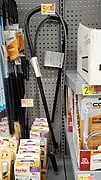Auger varieties
Plumber's snakes have a coiled (helix-shaped) metal wire with a broader gap between the coils at the terminal end. The operator turns a crank to rotate the helix as it moves through the pipe.
If the clog is caused by a dense, but shreddable obstacle, such as tree roots or glass wool, the auger might break it up enough to enable flow. A small, lightweight obstruction might be snagged or corkscrewed by the auger, enabling the operator to pull it away. As the auger cable rotates, it also flails against the interior walls of the pipe, scraping off minerals and oil.
Hand auger / hand spinner
Hand augers are useful for clearing sink and bathtub drains. They are unsuitable for sending through flush toilets, because the wire might damage the bowl; also, flush toilets have relatively large drain channels in which the narrow snake can become tangled. (A 1⁄4-inch cable, for example, should never be used in a drain with a calibre of more than two inches.)
Closet auger / toilet auger
The closet auger (named after water closet ) feeds a relatively short auger through a hook-shaped length of metal tubing. The hook shape makes it easier to feed the auger into the toilet. A plastic or rubber boot on the end of the rigid tubing protects the finish of the visible porcelain. Since most toilet clogs occur in the trap built into the bowl, the short cable is sufficient to break up or retrieve the majority of clogs.
Drum augers
A drum auger is a motorized auger with modular blades designed for various gauges of pipe. A drum auger is powerful enough to cut through tree roots. Used unskillfully, they can also damage plastic pipework and even copper tubing.
Roto-Rooter
The Roto-Rooter is an electric auger invented in 1933 by Samuel Blanc, an American. His wife named the invention, because the cable and blades rotated as they cut through tree roots inside sewer pipe. Competing companies made imitations after Blanc's patent expired in 1953, but the namesake machine is manufactured by and for a US company called the Roto-Rooter Plumbing & Drain Service.

Plumbing is any system that conveys fluids for a wide range of applications. Plumbing uses pipes, valves, plumbing fixtures, tanks, and other apparatuses to convey fluids. Heating and cooling (HVAC), waste removal, and potable water delivery are among the most common uses for plumbing, but it is not limited to these applications. The word derives from the Latin for lead, plumbum, as the first effective pipes used in the Roman era were lead pipes.

Drainage is the natural or artificial removal of a surface's water and sub-surface water from an area with excess water. The internal drainage of most agricultural soils can prevent severe waterlogging, but many soils need artificial drainage to improve production or to manage water supplies.
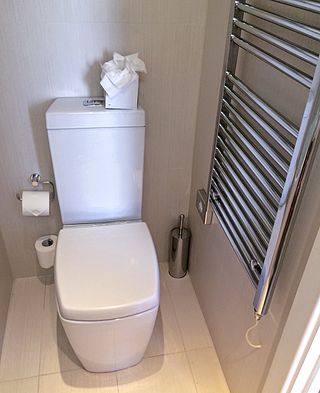
A flush toilet is a toilet that disposes of human waste by using the force of water to flush it through a drainpipe to another location for treatment, either nearby or at a communal facility, thus maintaining a separation between humans and their waste. Flush toilets can be designed for sitting or squatting, in the case of squat toilets. Most modern sewage treatment systems are also designed to process specially designed toilet paper. The opposite of a flush toilet is a dry toilet, which uses no water for flushing.

A plunger is a device driven by or against fluid pressure. In plumbing, the term plunger commonly refers to handheld tools used to clear blockages in drains and pipes. Plumbing plungers consist of a rubber suction cup attached to a stick (shaft) usually made of wood or plastic. A different bellows-like design also exists, usually constructed of plastic. Alternate names for plumbing plungers include force cup, plumber's friend or plumber's helper.
A drain cleaner or opener is a person, device or product unblocking sewer pipes or clogged wastewater drains. The term usually refers to a chemical or mechanical utensil such as a commercial chemical product, plumber's snake, drain auger or toilet plunger. Occasionally, it is applied to a plumber or another individual who performs the drain cleaning and hygiene.

A tap is a valve controlling the release of a fluid.
A plumbing fixture is an exchangeable device which can be connected to a plumbing system to deliver and drain water.

A French drain is a trench filled with gravel or rock, or both, with or without a perforated pipe that redirects surface water and groundwater away from an area. The perforated pipe is called a weeping tile. When the pipe is draining, it "weeps", or exudes liquids. It was named during a time period when drainpipes were made from terracotta tiles.

In modern plumbing, a drain-waste-vent is a system that allows air to enter the plumbing system to maintain proper air pressure to enable the removal of sewage and greywater from a dwelling. Drain refers to water produced at fixtures such as sinks, and showers; waste refers to water from toilets. As the water runs down, proper venting is required to allow water to flow freely, and avoid a vacuum from being created. As the water runs down air must be allowed into the waste pipe either through a roof vent (external), or an internal vent.

Roto-Rooter Plumbing & Water Cleanup is a Cincinnati, Ohio based plumbing company. The company, founded in 1935, originally specialized in clearing tree roots and other obstructions from sewer lines.

A wet wipe, also known as a wet towel, moist towelette, disposable wipe, disinfecting wipe, or a baby wipe is a small to medium-sized moistened piece of plastic or cloth that either comes folded and individually wrapped for convenience or, in the case of dispensers, as a large roll with individual wipes that can be torn off. Wet wipes are used for cleaning purposes like personal hygiene and household cleaning; each is a separate product depending on the chemicals added and medical or office cleaning wipes are not intended for skin hygiene.
Cross-linked polyethylene, commonly abbreviated PEX, XPE or XLPE, is a form of polyethylene with cross-links. It is used predominantly in building services pipework systems, hydronic radiant heating and cooling systems, domestic water piping, insulation for high tension electrical cables, and baby play mats. It is also used for natural gas and offshore oil applications, chemical transportation, and transportation of sewage and slurries. PEX is an alternative to polyvinyl chloride (PVC), chlorinated polyvinyl chloride (CPVC) or copper tubing for use as residential water pipes.
A grinder pump is a wastewater conveyance device. Waste from water-using household appliances flows through the home’s pipes into the grinder pump’s holding tank. Once the wastewater inside the tank reaches a specific level, the pump will turn on, grind the waste into a fine slurry, and pump it to the central sewer system or septic tank.
Pipeline video inspection is a form of telepresence used to visually inspect the interiors of pipelines, plumbing systems, and storm drains. A common application is for a plumber to determine the condition of small diameter sewer lines and household connection drain pipes.

A fitting or adapter is used in pipe systems to connect sections of pipe or tube, adapt to different sizes or shapes, and for other purposes such as regulating fluid flow. These fittings are used in plumbing to manipulate the conveyance of fluids such as water for potatory, irrigational, sanitary, and refrigerative purposes, gas, petroleum, liquid waste, or any other liquid or gaseous substances required in domestic or commercial environments, within a system of pipes or tubes, connected by various methods, as dictated by the material of which these are made, the material being conveyed, and the particular environmental context in which they will be used, such as soldering, mortaring, caulking, Plastic welding, welding, friction fittings, threaded fittings, and compression fittings.

In plumbing, a trap is a U-shaped portion of pipe designed to trap liquid or gas to prevent unwanted flow; most notably sewer gases from entering buildings while allowing waste materials to pass through. In oil refineries, traps are used to prevent hydrocarbons and other dangerous gases and chemical fumes from escaping through drains. In heating systems, the same feature is used to prevent thermo-siphoning which would allow heat to escape to locations where it is not wanted. Similarly, some pressure gauges are connected to systems using U bends to maintain a local gas while the system uses liquid. For decorative effect, they can be disguised as complete loops of pipe, creating more than one U for added efficacy.
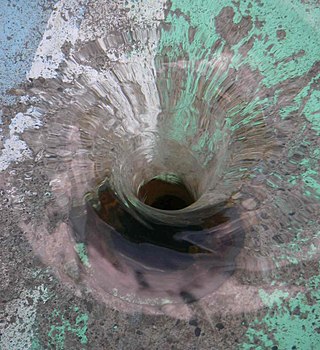
A drain is the primary vessel or conduit for unwanted water or waste liquids to flow away, either to a more useful area, funnelled into a receptacle, or run into sewers or stormwater mains as waste discharge to be released or processed.

A toilet is a piece of sanitary hardware that collects human urine and feces, and sometimes toilet paper, usually for disposal. Flush toilets use water, while dry or non-flush toilets do not. They can be designed for a sitting position popular in Europe and North America with a toilet seat, with additional considerations for those with disabilities, or for a squatting posture more popular in Asia, known as a squat toilet. In urban areas, flush toilets are usually connected to a sewer system; in isolated areas, to a septic tank. The waste is known as blackwater and the combined effluent, including other sources, is sewage. Dry toilets are connected to a pit, removable container, composting chamber, or other storage and treatment device, including urine diversion with a urine-diverting toilet.

A urine-diverting dry toilet (UDDT) is a type of dry toilet with urine diversion that can be used to provide safe, affordable sanitation in a variety of contexts worldwide. The separate collection of feces and urine without any flush water has many advantages, such as odor-free operation and pathogen reduction by drying. While dried feces and urine harvested from UDDTs can be and routinely are used in agriculture, many UDDT installations do not apply any sort of recovery scheme. The UDDT is an example of a technology that can be used to achieve a sustainable sanitation system. This dry excreta management system is an alternative to pit latrines and flush toilets, especially where water is scarce, a connection to a sewer system and centralized wastewater treatment plant is not feasible or desired, fertilizer and soil conditioner are needed for agriculture, or groundwater pollution should be minimized.
Chemical drain cleaners or openers are pure or mixtures of chemicals used to unclog drains that are blocked by hair, food, or other organic materials. They are often accompanied by other mechanical drain cleaners for the optimal effect. Chemical drain cleaners are available through hardware stores, although some may be intended for use by licensed plumbers. They may contain either strong acids or strong alkalis. These cleaners contain chemicals that dissolve at least some of the material causing the clog.
